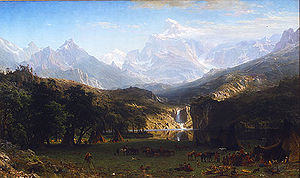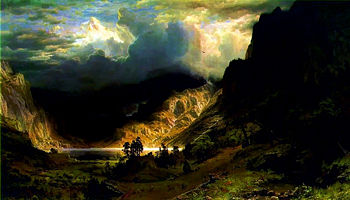Bierstadt, Albert
(→Career) |
(→Career) |
||
| Line 34: | Line 34: | ||
==Career== | ==Career== | ||
| − | On his return to New England Bierstadt set to work in earnest and when he first opened his studio to the public the public and the press were surprised by his talent. His reputation had been private up to this point with one or two works in local homes. He worked with an energy that did not fail him over the next forty years. Within a month he'd produced four major European landscapes. | + | On his return to New England Bierstadt set to work in earnest and when he first opened his studio to the public the public and the press were surprised by his talent. His reputation had been private up to this point with one or two works in local homes. He worked with an energy that did not fail him over the next forty years. Within a month he'd produced four major European landscapes, including, Spear Fishing (Lake Lucerne) 1857-58. Oil on canvas, 311/2x49," which was mentioned in the local press. |
| + | At this time he advertised to teach but in a year and a had only four pupils. It was during this time that he painted one of his few portraits that of an old Indian woman, Martha Simon, 1857, Oil on cardboard, 19x13." | ||
Revision as of 01:33, 27 May 2008
| Albert Bierstadt | |
 "Albert Bierstadt" by Napoleon Sarony | |
| Born | January 07 1830 Solingen, Germany |
| Died | February 18 1902 (aged 72) |
| Nationality | German-American |
| Field | painting |
| Training | Düsseldorf School |
| Movement | Hudson River School |
| Famous works | |
| Influenced | William Bliss Baker |
Albert Bierstadt (January 7 1830 - February 18 1902) was a German-American painter best known for his large landscapes of the American West. In obtaining the subject matter for these works, Bierstadt joined several journeys of the Westward Expansion. Though not the first artist to record these sites, Bierstadt was the foremost painter of these scenes for the remainder of the 19th century.
Bierstadt was part of the Hudson River School, not an institution but rather an informal group of like-minded painters. The Hudson River School style involved carefully detailed paintings with romantic, almost glowing lighting, sometimes called luminism.
Early Life
Bierstadt was born in Solingen, Germany. His family moved to New Bedford, Massachusetts, in 1833. In 1850 he decided on an art career and offered to teach monochromatic painting there. The following year after beginining to exhibit and sell a little he and by 1853 was able to inspire his family and others to send him to Düsseldorf to study in the studios there. His mother's cousin was a teacher there (Johan Peter Hasenclever) and at this point this was the newest and most popular of art schools. The members of the Düsseldorf School in Düsseldorf, descended from Peter von Cornelius, director of the Dusseldorf Academy, who'd made may reforms, such as, less stress on working from casts and more from life and stressed an emphasis on landscape painting, which Bierstadt liked. There was even a professorship for a landscape painter which was unique for it's time. Although Bierstadt had meant to study under Hasenclever, he had just died and the landscape teacher was absent, starting a school elsewhere. He turned to fellow American, Worthington Whittredge and Emmanuel Leutze. Leutze had painted Washington Crossing the Delaware and thought that, "Here was another waif to be taken care of." Whittredge thought otherwise noting the young artist's frugality. Whenever weather permitted, Albert traversed Westphalia filling his sketchbooks and making oil studies which he later worked up in the studio into full paintings. His work ethic was prodigious and he was said to never let any daylight go to waste. These works were then shipped off to New Bedford where they were duly sold soon giving him an income that he'd lacked. In 1856, he set off, with friends, from Germany, through Switzerland to Italy where he stayed for a year, studying and painting. On returning home via England he worked up his many European compositions into finished compositions that he sold to the Boston Atheneum. One work, The Old Mill, was sold separately to a New Bedford family and has remained in it ever since.
Career
On his return to New England Bierstadt set to work in earnest and when he first opened his studio to the public the public and the press were surprised by his talent. His reputation had been private up to this point with one or two works in local homes. He worked with an energy that did not fail him over the next forty years. Within a month he'd produced four major European landscapes, including, Spear Fishing (Lake Lucerne) 1857-58. Oil on canvas, 311/2x49," which was mentioned in the local press. At this time he advertised to teach but in a year and a had only four pupils. It was during this time that he painted one of his few portraits that of an old Indian woman, Martha Simon, 1857, Oil on cardboard, 19x13."
Bierstadt began making paintings in New England and upstate New York. In 1859, he traveled westward in the company of a Land Surveyor for the U.S. government, returning with sketches that would result in numerous finished paintings. In 1863 he returned West again, in the company of the author Fitz Hugh Ludlow, whose wife he would later marry. He continued to visit the American West throughout his career.
Though his paintings sold for princely sums, Bierstadt was not held in particularly high esteem by critics of his day. His use of uncommonly large canvases was thought to be an egotistical indulgence, as his paintings would invariably dwarf those of his contemporaries when they were displayed together. The romanticism evident in his choices of subject[1] and in his use of light was felt to be excessive by contemporary critics, a charge that continues to be leveled by many of today's art historians. His paintings emphasized atmospheric elements like fog, clouds and mist to accentuate and complement the feel of his work. Bierstadt sometimes changed details of the landscape to inspire awe. The colors he used are also not always true. He painted what he believed is the way things should be: water is ultramarine, vegetation is lush and green, etc. The shift from foreground to background was very dramatic and there was almost no middle distance.[citation needed]
Nonetheless, his paintings remain popular. He was a prolific artist, having completed over 500 [2] (possibly as many as 4000) paintings during his lifetime, most of which have survived. Many are scattered through museums around the United States. Prints are available commercially for many. Original paintings themselves do occasionally come up for sale, at ever increasing prices.
Existing Work
- Oregon Trail, 1869 at the Butler Institute of American Art
- Alaskan Coast Range, ca. 1889 at the Smithsonian American Art Museum
- Among the Sierra Nevada, California, 1868 at the Smithsonian American Art Museum
- Domes of Yosemite ca. 1871 at the St. Johnsbury Athenaeum, St. Johnsbury, Vermont
- Cathedral Rocks, Yosemite Valley, ca. 1872 at the Smithsonian American Art Museum
- Gates of the Yosemite, ca. 1882 at the Smithsonian American Art Museum
- Indians in Council, California, ca. 1872 at the Smithsonian American Art Museum
- San Francisco Bay, 1871-1873 at the Smithsonian American Art Museum
- Sunrise in the Sierras, ca. 1872 at the Smithsonian American Art Museum
- Sierra Nevada Morning at the Gilcrease Museum
Legacy
Because of Bierstadt's interest in mountain landscapes, Mount Bierstadt in Colorado is named in his honor. Another Colorado mountain was originally named Mount Rosa, after Bierstadt's wife, but it was later renamed Mount Evans after Colorado governor John Evans.
In 1998, the United States Postal Service issued a set of 20 commemorative stamps entitled "Four Centuries of American Art," one of which featured Albert Bierstadt's The Last of the Buffalo. [1]
William Bliss Baker, another landscape artist, studied under Bierstadt.
Gallery
Mount Hood, 1869
Moat Mountain, Intervale, New Hampshire
Yosemite Valley Yellowstone National Park
Yosemite Valley, California
Western Kansas
Staubbach Falls Near Lauterbrunnen Switzerland
A Rocky Mountain Sheep Ovis, Montana
See also
- History of painting
- Western painting
- Edward Bierstadt
Notes
ReferencesISBN links support NWE through referral fees
- Anderson, Nancy K. et. at. Albert Bierstadt, Art & Enterprise, Hudson Hills Press, Inc.: New York, New York, 1990.
- Hendricks, Gordon. Albert Bierstadt, Painter of the American West, Harrison House/Harry N. Abrams, Inc.: New York, New York 1988.
External links
- White Mountain paintings by Albert Bierstadt. Retrieved May 3, 2008.
- Albert Bierstadt Biography and Images: Hollis Taggart Galleries. Retrieved May 3, 2008.
- Gallery of Bierstadt's Paintings. Retrieved May 3, 2008.
- The Winterthur Library Overview of an archival collection on Albert Bierstadt. Retrieved May 3, 2008.
| ||||||||||||||
Credits
New World Encyclopedia writers and editors rewrote and completed the Wikipedia article in accordance with New World Encyclopedia standards. This article abides by terms of the Creative Commons CC-by-sa 3.0 License (CC-by-sa), which may be used and disseminated with proper attribution. Credit is due under the terms of this license that can reference both the New World Encyclopedia contributors and the selfless volunteer contributors of the Wikimedia Foundation. To cite this article click here for a list of acceptable citing formats.The history of earlier contributions by wikipedians is accessible to researchers here:
The history of this article since it was imported to New World Encyclopedia:
Note: Some restrictions may apply to use of individual images which are separately licensed.


















